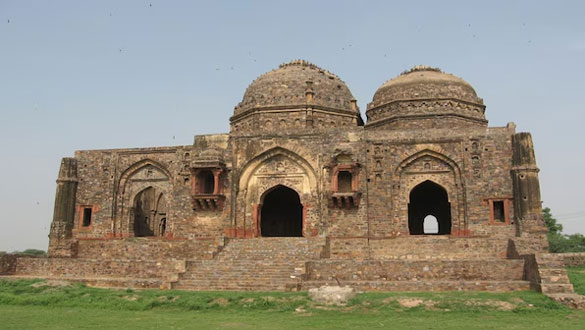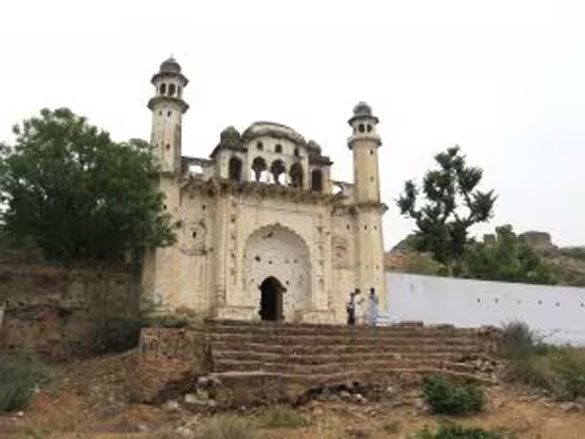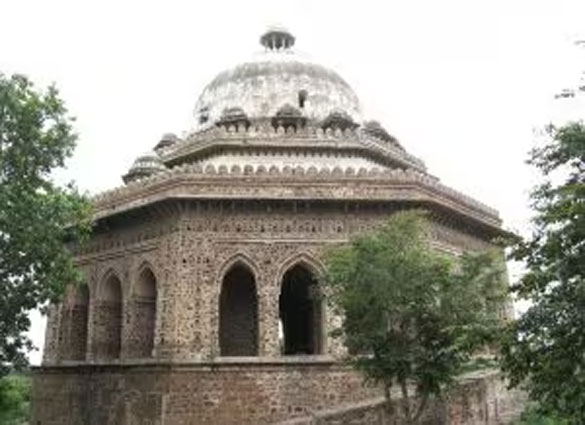Mewat - A Region of Mixed Identities and Communal Tensions
By Arjun Kumar
August 3,
2024
The Extreme Orthodoxy
That One Witnesses in This Region Encompassing Parts of the Modern-Day States of
Haryana, Rajasthan, And Uttar Pradesh in Northwestern India Is Often Attributed
to The Tablighi Jamaat, Which Was Born In Mewat In 1927
------

The
Lal Masjid at Tijara, in Rajasthan's Alwar district
------
To most
people, Gurugram is a metropolis. Sometimes referred to as ‘Millennium City’ on
account of the extraordinary growth it witnessed from the late 1990s onwards,
the city may seem a shining star in the corporate firmament of India, but to an
explorer it appears more like an island of modernity touching the urban chaos
of the national capital. And a short drive east, west or south of the city
reveals rustic waves in the ocean that surrounds it. And sometimes those waves
threaten to engulf it.
Between
July and September last year, those waves did come a wee bit close. In the form
of a riot that began in Nuh and triggered restrictions that impacted the
Millennium City too! Section 144 was imposed at the end of July and mobile
internet was suspended to prevent the spread of rumours and fake news. The news
that was factually correct was that a religious procession did trigger violence
in Nuh in the form of stone pelting, six people died including two home guards
and the cleric of a Gurugram mosque, a car was torched in Sohna and the region
remained tense for a while.
Most folks
saw this incident in isolation but if they were to study the deeper history of
the region, there is a pattern to this, perhaps emanating from the confused
identities of its inhabitants. And when the ‘region’ is mentioned, it is not
limited to the confines of the Nuh district of Haryana but touches parts of
Faridabad, Gurugram and enters Alwar in neighbouring Rajasthan as well. A
region that is called Mewat, and whose people were termed ‘Meos’ – a name that
seems to have fallen out of usage over the last decade and a half.
According
to scholar Suraj Bhan Bhardwaj, the Meos originally lived in the hills and
forests of the Aravalli ranges. From these secluded strongholds, they foraged
northward into towns and cities – in fact, into the edges of Delhi itself -
indulging in cattle-lifting, violent raids and robberies, causing fear in the
population. In the latter part of the 13th century CE, the Mamluk Sultan
Ghiyas-ud-din Balban (reign 1266-87) decided to crush these raids once and for
all. His troops moved into the area, the forests began to be cut down,
garrisons established and new roads built and existing routes made more secure
for travellers.
The trigger
for Balban’s action has been described by the Muslim thinker Barani, in these
words (translation): “The turbulence of the Mewatis had increased, and their
strength had grown in the neighbourhood of Dehli… At night they used to come
prowling into the city, giving all kinds of trouble, depriving the people of
their rest; and they plundered the country houses in the neighbourhood of the
city. In the neighbourhood of Dehli there were large and dense jungles, through
which many roads passed. The disaffected in the Doáb, and the outlaws towards
Hindustan grew bold and took to robbery on the highway, and they so beset the
roads that caravans and merchants were unable to pass. The daring of the
Mewatis in the neighbourhood of Dehli was carried to such an extent that the
western gates of the city were shut at afternoon prayer, and no one dared to go
out of the city in that direction after that hour, whether he travelled as a
pilgrim or with the display of a sovereign. At afternoon prayer the Mewatis
would often come to the Sar-hauz, and
assaulting the water-carriers and the girls who were fetching water, they would
strip them and carry off their clothes.”
Another
version of this trigger, given by Sandeep Balakrishna of the Dharma Dispatch,
is that the Meos were originally Yaduvanshi Rajputs who made this forested
region their bastion for a stand against the Delhi Sultanate. While forcefully
entering the region, Balban did a few more things – post a mass slaughter of
Meos, he began giving tracts of land in Mewat to his soldiers for them to
settle there. And importantly, he converted most of the remaining Meos to
Islam. Let’s see how that turned out.
Cut to
2016! A newspaper report titled ‘Gangs
of Mewat’, referring to Nuh district, mentioned that two Mewati Imams had
been arrested for alleged terror links. The report quoted a police officer as
saying that while the gangs operating here used to steal cattle or motorbikes
earlier, they had since become more organised and had begun robbing trucks on
highways and even kidnapping drivers for ransom. The cop also mentioned that if
these gangs were ever intercepted, they were prone to extreme violence. Shades
of the 13th century?
While
Balban’s forced conversion may have failed in his intended objective of ending
the lawlessness of the region, it left its visible imprint here. As one drives
south of Gurugram, the glass and chrome towers are quickly replaced by fields,
and instead of corporate executives we come across peasants engaged in
agricultural pursuits. The remarkable aspect of these agriculturists is that
they are almost uniformly Islamic in their faith. But a more nuanced probing
shows that there is little that is uniform in their customs and practices.
Among the
first villages that appear is the quaintly named Sanp ki Nangli. Hidden away in its folds are several tombs,
appearing like stragglers from history and separated from each other by fields.
Their external plaster has long since fallen, taking with it the embellishment
they may have had, but the structures still reveal signs of past grandeur. An
elegant dome atop one, designs on pillars in another, faint traces of painting
in a third. And a fourth tomb that has become part of a peasant’s house. When
this author entered the tomb, a bored looking buffalo looked up. The tombstone
this animal was standing on was of one of the Khanzadas, rulers of this region between the 15th and 16th centuries
CE. The monuments built by them dot Tauru, Bhondsi and Sohna also.
Further
down the road is Nuh, headquarters of the Haryana district of Mewat. Pronounced
‘Nuhu’ by locals, its parameters
point it to being the least developed district of the state. The gender ratio
is massively skewed, in favour of the male population. As per the 2016 report,
the place recorded 44,000 kids born every year but had no gynaecologist; it
contributed to at least a fourth of the incarcerated prisoners in the jails of
Bhondsi and Faridabad, as well as Alwar. Literacy was the least in the state
and only a fraction of those enrolled in primary school reached class 10.
Female enrolment in colleges was miniscule. There was limited water available
for agriculture. During the pandemic, people seemed more apprehensive about
getting themselves vaccinated than about Covid itself. In this scenario, crime
thrived. As it had in the 13th century too!
And yet
amidst all this, lay the tiny tomb complex of Sheikh Musa, at the outskirts of
Nuh town. Dating to the 14th century CE, the most interesting feature of the
tomb complex is its gateway. The twin minarets that flank the gateway on either
side have the reputation of ‘shaking’. When this author first made the trip to
Nuh and climbed up to the top of a minaret, two men sitting on the opposite one
showed him how the mechanism worked. Apparently, if you held one of the
supporting pillars at the top of a minaret and tried to shake it, movement
could be discerned in the opposite minaret. A demonstration of the process left
this author stunned. For a few seconds, the minaret shook as if a tremor had
taken hold. Truly an engineering wonder – one that could outclass any of
Gurgaon’s glass towers in solidity.

A
decade old picture of the gateways of the Sheikh Musa tomb in Nuh - the two
minarets with the shaking effect on either side
------
South of
Nuh lies the village of Kotla, home to a large mosque whose architecture
resembles that of the Tughlaqs. Atop a hill here are the remains of an old
fort. Locals at the mosque advised the author to avoid going up – apparently,
some illegal rock mining was being done there with the ‘miners’ not being the
welcoming sort.
The next
stop was the village of Ferozepur Jhirka, the objective here being a tomb
complex remarkable for its design. When shown a picture of the structure, a
couple of elderly Muslim gentlemen pointed this author in the direction of the
place. But curiously, they referred to it as a ‘Mandir’ or temple. On reaching the place, it looked exactly like an
Islamic mausoleum.
Standing on
a high platform and looking like a small fort, the tomb complex bore a strong
structural resemblance to the tomb of Sultan Ghari, near Vasant Kunj in Delhi.
Inside was a building named Masjid Nahar Khor. Some of the stones on its walls
carried patterns of elephants and horses – this depiction of living creatures
on an Islamic building was entirely out of place. However, when this use of
animal motifs is put alongside the reference to the place as a temple and the
fact that the Islamic folk in the village do not worship here, it shows that
the place may have been the site of a temple, now long lost. Perhaps the
conversion of the populace was accompanied by a changeover of their
architectural heritage also.
Not that
the change met its aim of making them law abiding. In the violence of 2023 that
impacted Nuh and touched the edge of Gurugram, Mamman Khan, the MLA
representing Ferozepur Jhirka was one of the accused and was later arrested
from Jaipur.
Research
has revealed that centuries after their conversion, the Meos retained links to
their roots, drawing pride in being Rajputs, often observing Hindu customs
during ceremonies. They had even created their own version of the Mahabharata
epic – the Panduan ka Kara, which was
recited by fakirs wandering in the region. The extreme orthodoxy that one
witnesses in the region today is often attributed to the Tablighi Jamaat – which was born in Mewat in 1927 – and was aimed
at getting Muslims to be more religiously observant. Looking around Mewat
today, the results are all too obvious.
The town of
Tijara, in neighbouring Alwar district, is also a part of Mewat region. But it
appears more prosperous than Nuh, its population mix more pluralistic. A
hilltop fort, once in ruin, is now a marvellous heritage hotel, run by Neemrana
Hotels. Alongside the road leading from Tijara town to the hotel lies the
medieval Lal Masjid, a huge three-bay building that was once the congregational
mosque of the place. But the mixed identities never quite go away, and here
they are manifest in a large, octagonal tomb in the town. The structure exactly
resembles the octagonal Lodi and early Mughal mobility tombs. But locals refuse
to accept it as a tomb. Instead, it is called ‘Bhartari ka Gumbad’ with Bhartari being the former Hindu King of
Ujjain who came to Tijara to do penance. Another example of mixed identities
here!

Octagonal
structure named Bhartari ka Gumbad in Tijara, Alwar
------
What does
the future hold for this region of mixed identities? While aspects such as
immunisation have shown a great improvement over the last decade, progress in
infrastructure has also brought a fillip in criminal activities. A 2024 report
shows a high incidence of cybercrime emanating from this region, with as many
as 500 cases of cyber fraud being registered daily. And unlike the highway
robberies of the past which mostly involved young men, this time even women and
the elderly seem to be participating in crime. Reforming this region does not
need the violent approach of a fanatical Balban but an inspired administrator.
In July
this year, the religious procession that came to Nuh was not greeted with stone
pelting but with garlands, by both Hindus and Muslims. Yes, police presence was
strong and mobile internet was kept under check. But there is hope that if
people of the region work together towards a better future, the energies
expended on crime may be more usefully deployed in better pursuits.
Source: Mewat: Once A Region with Mixed Identities, Now Marred By Communal
Tensions
-----
Arjun Kumar is a heritage explorer by inclination with a penchant for
seeking obscure sites. A brand consultant by profession
Views expressed in the above piece are personal and solely those of the
author. They do not necessarily reflectNew Age Islam's views.
URL: https://www.newageislam.com/interfaith-dialogue/mewat-mixed-identities-communal-tensions/d/132861
New Age Islam, Islam Online, Islamic
Website, African Muslim News, Arab World News, South Asia News, Indian Muslim News, World Muslim News, Women in Islam, Islamic Feminism, Arab Women, Women In Arab, Islamophobia in America, Muslim Women in West, Islam Women and Feminism
